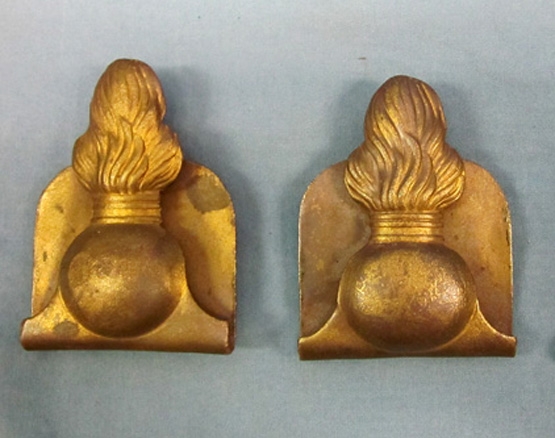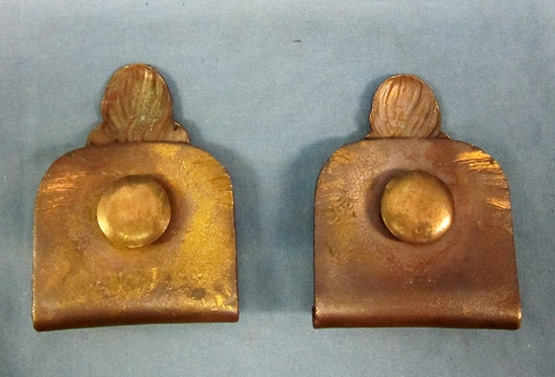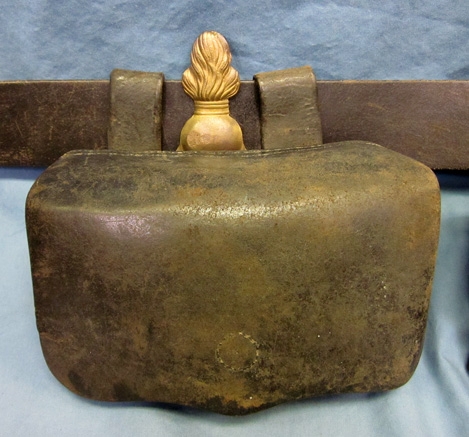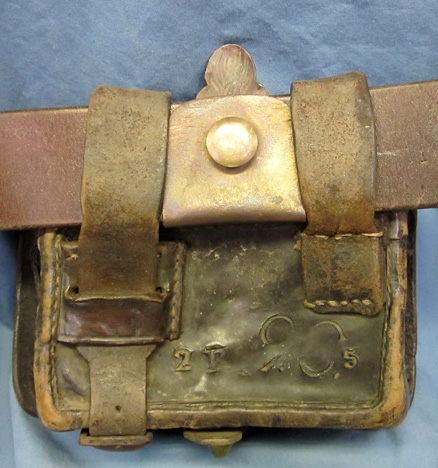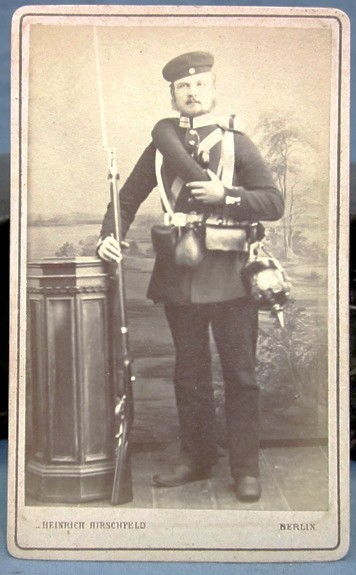German, Franco-Prussian Era, Garde Pattern Belt Support Hooks
This item is listed for historical interest only. It was listed on our site previously but has
been sold and is no longer available for purchase.
Sold for: $150.00
German, Franco-Prussian Era, Garde Pattern Belt Support Hooks
This item is listed for historical interest only. It was listed on our site previously but has
been sold and is no longer available for purchase.
Sold for: $150.00
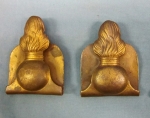 Original period manufacture. After a recent purchase, room (and funds) needed to be found to help defray the expense. These are fairly scarce items I would think, they are the only pair to ever cross my path in near 50 years. The price is for the two hooks only, the pouches and CDV are being used for illustration purposes. What follows below is an article I wrote for Pickelhaubes.com in 2011 giving a brief description regarding these.*****Recently I was very happy to findthese little brass tornister strap belt supports for sale. I was completelyunaware of their existence prior to the purchase of the two volume set, TheGerman Infantry, Uniforms and Equipment from 1871-1914 by Ulrich Herr and JensNguyen. There on page 120 is a photo of two different examples of thesesupports, one of which is similar to mine describing these as being adopted in1874 and replaced in 1887, due to the adoption of a new pattern cartridgepouch. When I saw them come up for bid on Ebay.Fr I thought these are greatlittle items, just too bad they are post 1870, which is my primary era of interest.However, after having a look through Formations und Uniformierungsgeschichtedes Prussischen Heeres 1808 bis 1914 by Paul Pietsch, similar tornister hooksof both Garde & Line pattern are shown on page 109 as having been adoptedin 1847. Hmmmm. My German language skills are minimal at best, but what Icould decipher from the text appears to quote an A.K.O. from 1847 specifyingGranatenform brass hooks for the Garde on the new pack system. In the H&Nreference there are two Garde pattern hooks illustrated, one has a series ofpierced openings for stitching (shown in Pietsch), while the other is withoutstitch holes (not shown in Pietsch). The non-pierced example perhaps uses abrass button on the reverse to attach to the end of the tornister strap as myexamples do. I realize this is much-ado-about-nothing in the scheme of things,but the question piqued my interest. Is the plain Garde hook the 1874 patternthat H&N refer to and the pierced example the true 1847 pattern? The LineInfantry hook in our photo (field recovered near Metz) shown to the right ofour Garde pair, has a stitch pattern too. Is perhaps the difference in thePietsch and H&N texts merely a transposition of two digits, overlooked inthe proofread of H&Ns book? Did two distinct styles of Garde hooks existedsimultaneously from 1847-1887, perhaps simply a manufacturers difference?Anyone know for sure? I pulled out my box of periodphotography to have a look to see if any examples of these Garde pattern hooksin use could be found,. lo and behold one was there. The Garde Grenadier isarmed with a M1862 zundnadelgewehr with his M1860 Garde pickelhaube hanging byits chinstrap from the hilt of his Faschinenmesser. With the CDV in hand theGarde style hooks are clearly seen. However my photographic skills dont bringit out very well, but looking closely they are there nonetheless. The CDV imageof the Fusilier armed with the M1871 Rifle and equipped with the 1874 pouchesis quite clear. The Line pattern belt support hooks are easily seen.Front and rear views of the M1850,M1874 and M1887 pouches with the hook supports installed between the belt loopsare provided. White straps Grenadier companies, black straps Fusiliercompanies. Prior to 1887 the M1850 and M1874 cartridge boxes were without any supportloops on the reverse. They were provided with elongated belt loops whichallowed the pouch to hang below the bottom of the waist belt. These Garde andLine pattern tornister hooks then slipped between the cartridge box belt loopsand provided much needed support for the weight of the ammunition. In 1887 anewly designed cartridge pouch was introduced which was provided with arectangular brass loop sewn to the reverse of the pouch. A simplified hook atthe end of the tornister strap slipped through this hook and provided similarsupport to the waist belt.
Original period manufacture. After a recent purchase, room (and funds) needed to be found to help defray the expense. These are fairly scarce items I would think, they are the only pair to ever cross my path in near 50 years. The price is for the two hooks only, the pouches and CDV are being used for illustration purposes. What follows below is an article I wrote for Pickelhaubes.com in 2011 giving a brief description regarding these.*****Recently I was very happy to findthese little brass tornister strap belt supports for sale. I was completelyunaware of their existence prior to the purchase of the two volume set, TheGerman Infantry, Uniforms and Equipment from 1871-1914 by Ulrich Herr and JensNguyen. There on page 120 is a photo of two different examples of thesesupports, one of which is similar to mine describing these as being adopted in1874 and replaced in 1887, due to the adoption of a new pattern cartridgepouch. When I saw them come up for bid on Ebay.Fr I thought these are greatlittle items, just too bad they are post 1870, which is my primary era of interest.However, after having a look through Formations und Uniformierungsgeschichtedes Prussischen Heeres 1808 bis 1914 by Paul Pietsch, similar tornister hooksof both Garde & Line pattern are shown on page 109 as having been adoptedin 1847. Hmmmm. My German language skills are minimal at best, but what Icould decipher from the text appears to quote an A.K.O. from 1847 specifyingGranatenform brass hooks for the Garde on the new pack system. In the H&Nreference there are two Garde pattern hooks illustrated, one has a series ofpierced openings for stitching (shown in Pietsch), while the other is withoutstitch holes (not shown in Pietsch). The non-pierced example perhaps uses abrass button on the reverse to attach to the end of the tornister strap as myexamples do. I realize this is much-ado-about-nothing in the scheme of things,but the question piqued my interest. Is the plain Garde hook the 1874 patternthat H&N refer to and the pierced example the true 1847 pattern? The LineInfantry hook in our photo (field recovered near Metz) shown to the right ofour Garde pair, has a stitch pattern too. Is perhaps the difference in thePietsch and H&N texts merely a transposition of two digits, overlooked inthe proofread of H&Ns book? Did two distinct styles of Garde hooks existedsimultaneously from 1847-1887, perhaps simply a manufacturers difference?Anyone know for sure? I pulled out my box of periodphotography to have a look to see if any examples of these Garde pattern hooksin use could be found,. lo and behold one was there. The Garde Grenadier isarmed with a M1862 zundnadelgewehr with his M1860 Garde pickelhaube hanging byits chinstrap from the hilt of his Faschinenmesser. With the CDV in hand theGarde style hooks are clearly seen. However my photographic skills dont bringit out very well, but looking closely they are there nonetheless. The CDV imageof the Fusilier armed with the M1871 Rifle and equipped with the 1874 pouchesis quite clear. The Line pattern belt support hooks are easily seen.Front and rear views of the M1850,M1874 and M1887 pouches with the hook supports installed between the belt loopsare provided. White straps Grenadier companies, black straps Fusiliercompanies. Prior to 1887 the M1850 and M1874 cartridge boxes were without any supportloops on the reverse. They were provided with elongated belt loops whichallowed the pouch to hang below the bottom of the waist belt. These Garde andLine pattern tornister hooks then slipped between the cartridge box belt loopsand provided much needed support for the weight of the ammunition. In 1887 anewly designed cartridge pouch was introduced which was provided with arectangular brass loop sewn to the reverse of the pouch. A simplified hook atthe end of the tornister strap slipped through this hook and provided similarsupport to the waist belt.
Photos of German, Franco-Prussian Era, Garde Pattern Belt Support Hooks
